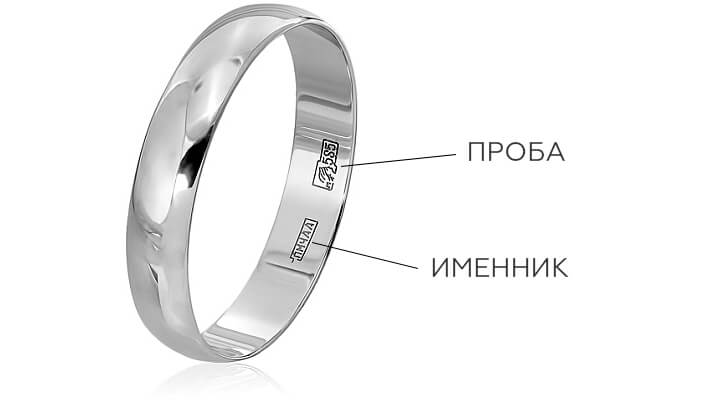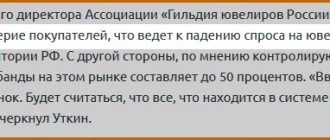After the collapse of the Soviet Union, a new page was opened in the history of hallmarking - the next period of introducing state samples and hallmarks began.
On February 28, 1992, the codes of state inspections were officially approved, and the hallmark certification mark was also approved.
It is noteworthy that the state hallmark was based on a pre-revolutionary image - the profile of a girl in a kokoshnik, turned to the right. This decision is explained by the fact that the old Soviet version in the form of a hammer and sickle inscribed in a star lost its relevance with the change of power.
The Presidential Decree approving the “Regulations on hallmarking and hallmarking of products made of precious metals in the Russian Federation” was signed on October 2, 1992, but in fact, new types of hallmarks began to be introduced only in 1994.
Testing and marking: current legislation
Today, the affixing of state hallmarks is carried out by the Assay Chamber under the Ministry of Finance of the Russian Federation. This state institution is vested with such powers in accordance with the Decree of the Government of the Russian Federation No. 106 “On the Russian State Assay Office”.
Absolutely all products made of precious metals produced in Russia must comply with current standards. All samples are defined in the Decree of the Russian Federation No. 643 “On the procedure for assaying and branding products made of precious metals.” In addition, all such products must be branded with the state mark.
Procedure for marking jewelry
Jewelry must be marked during its production. Entrepreneurs will need to perform actions in a certain order:
- Create an enhanced qualified electronic signature (ECES). To do this, you should contact an accredited certification center. The electronic signature is issued to the person who has the right to act on behalf of the organization without a power of attorney. This point is stated in the statutory documents.
- Obtain a certificate from the Tax Service at the place of registration of the organization that will confirm the absence of debt. If there are tax debts, they will have to be paid.
- Purchase equipment and install the necessary software. You will need printers and scanners of RFID tags, as well as software that will allow you to read them. Detailed information can be obtained on the Goznak website.
- Join the GS1 RUS association. This organization distributes automatic identification tools and helps entrepreneurs involved in working with relevant products.
- Conclude an agreement with Goznak. Only after this can the entrepreneur be provided with labeling codes.
Important! An RFID tag is a special chip that allows you to read printed information about an object remotely. This is realized through a special scanner. Only after this will entrepreneurs be able to label their products in accordance with GOST.
In parallel with this, a sample is applied to the objects, which is also a sign of quality, but only means the percentage of metal in the composition. Labeling will allow you to track a wider range of data that is important to the end consumer.
Companies that decide to voluntarily join the experiment must fill out a form on the Goznak website. You will need to enter the specified data and follow the instructions.
We will introduce turnkey labeling of jewelry
What information is indicated on products made of precious metals?
Any products made of precious metals of modern domestic production must include:
A special manufacturer’s mark, which is affixed by a legal entity or individual entrepreneur (private craftsman or manufacturer).
The name plate may contain the following information:
Name marks must always be registered and approved by the Russian Ministry of Finance.
The hallmark indicates the fineness of the precious metal and contains a “branded image” - the profile of a girl in a kokoshnik.
Please note: the hallmark of the state inspection is placed not only on products that can be purchased in Russia. Such marks are also affixed to export products made of precious metals - this procedure is necessary to confirm compliance with the Russian state standard and the legality of trade.
- Manufacturer's name Year of manufacture of the product.
- Information about the state inspection to which this manufacturer belongs.
- Various individual signs in the form of numbers and letters that can identify the master of a particular product.

What types of jewelry are subject to marking?
The following materials and finished jewelry fall under the new requirements:
- powdered platinum and palladium;
- precious metals (platinum, palladium, silver and gold) in processed and unprocessed form;
- sapphires, emeralds, rubies;
- all types of diamonds (ungraded, processed, rough, loose);
- Golden coins.
Jewelry or parts of products made from the metals listed above (including those with galvanic coating and clad with other precious metals or stones) are also subject to identification with marking marks.
1. Ask our specialist a question at the end of the article. 2. Get detailed advice and a full description of the nuances! 3. Or find a ready-made answer in the comments of our readers.
Methods for branding products made of precious metals
There are three modern methods of branding products made of precious metals:
The impact or mechanical method is one of the most ancient branding methods, but is still popular.
Branding is carried out using a hammer or special machines for mass branding. Sometimes special anvils are used that fit the shape of the product.
Advantages of the impact method: obtaining clear impressions that are highly resistant and durable.
Disadvantages of the impact method: if there is insufficient experience or a violation of the branding technology or manufacturing of the product, it may become deformed or cracks may form in the metal.
A distinctive feature of this method is the application of imprints using copper electrode stamps using electric spark equipment.
The brand is burned out with a spark, so this method allows you to apply even complex images.
It is very easy to determine that the mark was applied using the electric spark method: thin bridges are clearly visible between the contours of the nameplate and its signs. This is a unique distinctive feature of this branding method.
Advantages of the electro-spark method: the prints are very clear and durable.
Disadvantages of the electric spark method: the surface of the product on which the stamp will be applied must be ideally prepared - clean, smooth and even.
The most modern branding method, which uses a laser machine and special stamp masks. As with the electro-spark method, it is important that the surface of the product on which the mark will be applied is perfectly flat, clean and smooth.
Advantages of the laser method: clear impressions and the ability to brand products of any shape and with any surface - hollow, concave, convex.
Disadvantages of the laser method: this method has almost no disadvantages, except for the need to carefully prepare the surface of the product for subsequent branding. Perhaps the only drawback of such a mark is its fragility. During wear, scratches inevitably appear on the jewelry, and the mark becomes unclear. When polished, such marks completely disappear from the surface of the product.
- Shock
- Electro-spark
- Laser
Features of marking
This experiment is focused on the interaction of state-owned enterprises and companies that are players in the business associated with the production and sale of jewelry. This action also applies to importing businessmen, who will be required to control products imported into the country.
The purpose of such an experiment is not only to effectively label jewelry, but also to label its components. Special nanomarks will be placed that will mark both the jewelry itself and its details and stones. Today the question is the technical implementation of such a solution.
Branding of stones should not affect their characteristics and presentation. Thus, the process of applying a nanotag should not involve factors such as high temperature or pressure.
It is also necessary to understand that such tags should not conflict with logistics solutions and jewelry production processes. At the moment, a new system for applying nanomarks has been developed - such a mark will not affect the appearance and characteristics of the stone, and will only be noticeable with a magnification of 500 times. As a rule, such a label will be useful not so much to consumers as to industry professionals.
The mark is applied to the finished product, but so far there are some technical restrictions imposed on such a process. The mark cannot be placed simultaneously with the imprint, since in this case, during processing, it may simply be erased during polishing. The most convenient solution is branding at the final stage of production.
Today, it is technical problems during the process that do not make it possible to launch the program for full operation this year. So far the government has not changed the official start date of the program - 2019-2020, however, experts do not exclude the possibility of postponing its start to a later date - 2024.
What will labeling jewelry products give the state?
Approximately 50% of jewelry sold on the Russian market is sold in circumvention of current legislation. That is, taxes from such transactions do not go to the treasury of the Russian Federation. Assigning unique identifiers to materials and finished products will allow you to track the entire path of the product and verify its authenticity at each stage of sales.
In addition to selling counterfeit products, dishonest sellers also falsify product characteristics. During production, each piece of jewelry is given a tag with a description of the product, which is secured with a seal. Any seller, if desired, can replace it with his own tag, indicating in the characteristics overweight, more expensive stones, etc.
QR codes on tags will allow you to find out all the information about the product using an application on your smartphone. You can check the validity of the received data from the seller by asking him to read the information from the nanotag located on the ring, bracelet or other jewelry.
Among other things, the new system of marking and branding of jewelry will make it possible to track the illegal income of individuals. Every person who buys jewelry worth more than 40,000 rubles in cash (or more than 100,000 by bank transfer) must present a passport or fill out a special form when making a transaction. Currently, this information is stored by sellers; tax officials can only view it when checking the store itself. The introduction of a unified information base will create the opportunity to check the data submitted by customers in a common system.
What entrepreneurs will need for mandatory labeling of jewelry: work in GIIS DMDK
On June 23, 2020, amendments to Federal Law No. 41-FZ of March 26, 1998 came into force, according to which a state integrated information system was introduced in the field of control over the circulation of precious metals, precious stones and products made from them (GIIS DMDK), created to track the movement of jewelry. Due to the postponement of mandatory labeling deadlines, the system currently continues to operate in beta testing mode and each market participant can try out the new operating procedure. To get started with GIIS DMDK, you must:
- Obtain an enhanced qualified signature.
- Install root and intermediate certificates of test certification authorities.
- Issue and install a test certificate for the head of the enterprise.
- Install Yandex Browser.
Detailed instructions for connecting to the system and links to installing certificates are posted on the Goznak JSC website.
After each transaction involving a marked commodity item (sale to the final consumer, wholesale distribution, transfer to a supplier), the seller must record in a unified system the fact of transfer of the goods within the period established by law. An online cash register connected to one of the accredited operators helps you always comply with this requirement. After the transaction is completed and the fiscal receipt has been punched, the information is transferred to the OFD, and he enters it into a unified system. That is, the seller does not need to perform unnecessary actions - everything happens automatically.
- Residue marking
1 review
3 ₽
3₽
https://online-kassa.ru/kupit/markirovka-ostatkov/
OrderMore detailsIn stock
- Training to work in the Honest Sign system
3 000 ₽
3 000₽
https://online-kassa.ru/kupit/obuchenie-rabote-v-sisteme-chestnyj-znak/
OrderMore detailsIn stock
- Digital signature for marking
2 000 ₽
2 000₽
https://online-kassa.ru/kupit/etsp-dlya-markirovki/
OrderMore detailsIn stock
Responsibility for the sale of unmarked goods
With the introduction of mandatory labeling of jewelry, penalties provided for violation of the requirements will also come into force. For the manufacture, transportation and sale of goods without identifiers, offenders face a fine:
- for organizations - in the amount of 50,000 to 300,000 rubles;
- for individual entrepreneurs - from 5,000 to 10,000 rubles.
In addition, in all cases, products without two-dimensional marks are confiscated from violators. When producing or selling labeled goods in especially large quantities (if the total cost of the products is more than 1.5 million rubles), criminal liability is provided in accordance with Article 171.1 of the Criminal Code of the Russian Federation.









